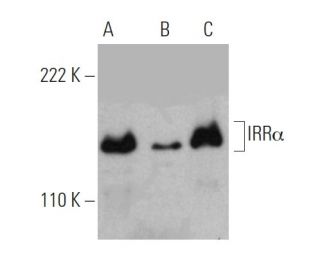



IRRα Antibody (D-3): sc-515888
- IRRα Antibody (D-3) is a mouse monoclonal IgG1 IRRα antibody provided at 200 µg/ml
- raised against amino acids 619-715 mapping within an internal region of IRR of human origin
- IRR alpha Antibody (D-3) is recommended for detection of IRRα of mouse, rat and human origin by WB, IP, IF and ELISA
- Anti-IRR alpha Antibody (D-3) is available conjugated to agarose for IP; HRP for WB, IHC(P) and ELISA; and to either phycoerythrin or FITC for IF, IHC(P) and FCM
- also available conjugated to Alexa Fluor® 488, Alexa Fluor® 546, Alexa Fluor® 594 or Alexa Fluor® 647 for WB (RGB), IF, IHC(P) and FCM, and for use with RGB fluorescent imaging systems, such as iBright™ FL1000, FluorChem™, Typhoon, Azure and other comparable systems
- also available conjugated to Alexa Fluor® 680 or Alexa Fluor® 790 for WB (NIR), IF and FCM; for use with Near-Infrared (NIR) detection systems, such as LI-COR®Odyssey®, iBright™ FL1000, FluorChem™, Typhoon, Azure and other comparable systems
- At present, we have not yet completed the identification of the preferred secondary detection reagent(s) for IRRα Antibody (D-3). This work is in progress.
QUICK LINKS
IRRα Antibody (D-3) is a mouse monoclonal IgG1 antibody that detects IRR alpha protein of mouse, rat, and human origin by western blotting (WB), immunoprecipitation (IP), immunofluorescence (IF), and enzyme-linked immunosorbent assay (ELISA). IRRα (D-3) antibody is available in both non-conjugated and various conjugated forms, including agarose, horseradish peroxidase (HRP), phycoerythrin (PE), fluorescein isothiocyanate (FITC), and multiple Alexa Fluor® conjugates. The insulin receptor-related receptor (IRR) plays a crucial role in cellular signaling pathways, particularly in insulin regulation, although specific ligand and biological functions remain largely unexplored. Structurally, IRR is synthesized as a single polypeptide precursor that undergoes proteolytic cleavage and glycosylation, resulting in alpha and beta subunits formation. Two IRRα subunits create the ligand-binding domain, while two IRRβ subunits house the kinase domain, essential for downstream signaling. IRR is predominantly expressed in brain, stomach, pancreas, and heart, with highest expression levels found in kidney, indicating potential importance in renal function and metabolic regulation. IRR gene is located on human chromosome 1q23.1, a region associated with type-2 diabetes mellitus, suggesting a significant role in insulin signaling and glucose homeostasis.
Alexa Fluor® is a trademark of Molecular Probes Inc., OR., USA
LI-COR® and Odyssey® are registered trademarks of LI-COR Biosciences
IRRα Antibody (D-3) References:
- Preserved pancreatic beta-cell development and function in mice lacking the insulin receptor-related receptor. | Kitamura, T., et al. 2001. Mol Cell Biol. 21: 5624-30. PMID: 11463843
- Polymorphism screening of the insulin receptor-related receptor gene (INSRR) on 1q in Pima Indians. | Wolford, JK., et al. 2001. Mol Cell Probes. 15: 223-7. PMID: 11513557
- Insulin receptor-related receptor messenger ribonucleic acid: quantitative distribution and localization to subpopulations of epithelial cells in stomach and kidney. | Mathi, SK., et al. 1995. Endocrinology. 136: 4125-32. PMID: 7649121
- Expression of a cDNA encoding the human insulin receptor-related receptor. | Jui, HY., et al. 1994. J Biol Chem. 269: 22446-52. PMID: 8071374
- Localization of insulin receptor-related receptor in the rat kidney. | Ozaki, K., et al. 1997. Kidney Int. 52: 694-8. PMID: 9291189
- Insulin receptor-related receptor in rat islets of Langerhans. | Ozaki, K. 1998. Eur J Endocrinol. 139: 244-7. PMID: 9724084
- Effect of fasting on insulin receptor-related receptor messenger ribonucleic acid in rat kidney. | Chrysis, D., et al. 1998. J Endocrinol. 159: R9-R12. PMID: 9795378
Ordering Information
| Product Name | Catalog # | UNIT | Price | Qty | FAVORITES | |
IRRα Antibody (D-3) | sc-515888 | 200 µg/ml | $316.00 | |||
IRRα Antibody (D-3) AC | sc-515888 AC | 500 µg/ml, 25% agarose | $416.00 | |||
IRRα Antibody (D-3) HRP | sc-515888 HRP | 200 µg/ml | $316.00 | |||
IRRα Antibody (D-3) FITC | sc-515888 FITC | 200 µg/ml | $330.00 | |||
IRRα Antibody (D-3) PE | sc-515888 PE | 200 µg/ml | $343.00 | |||
IRRα Antibody (D-3) Alexa Fluor® 488 | sc-515888 AF488 | 200 µg/ml | $357.00 | |||
IRRα Antibody (D-3) Alexa Fluor® 546 | sc-515888 AF546 | 200 µg/ml | $357.00 | |||
IRRα Antibody (D-3) Alexa Fluor® 594 | sc-515888 AF594 | 200 µg/ml | $357.00 | |||
IRRα Antibody (D-3) Alexa Fluor® 647 | sc-515888 AF647 | 200 µg/ml | $357.00 | |||
IRRα Antibody (D-3) Alexa Fluor® 680 | sc-515888 AF680 | 200 µg/ml | $357.00 | |||
IRRα Antibody (D-3) Alexa Fluor® 790 | sc-515888 AF790 | 200 µg/ml | $357.00 |
